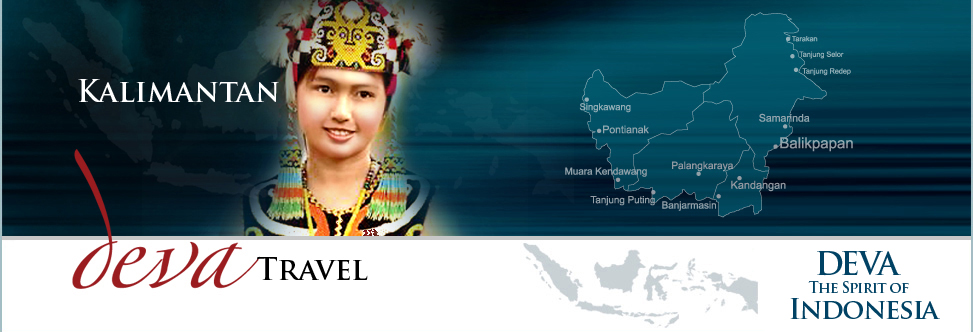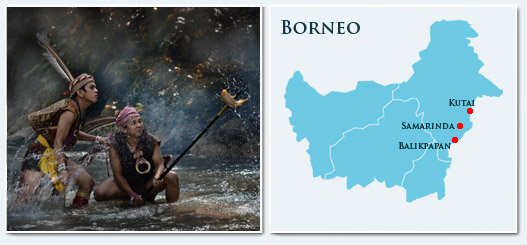Kalimantan

Day 1 Balikpapan - Loajanan
Upon arrival at Sepinggan airport of Balikpapan, there is a transfer to Loajanan for boarding on a houseboat.
A houseboat or Klotok is a traditional wooden river boat, about 12-metres by 2-metres with an upper deck from where you can view the rainforest. The boat will serve as your transportation, accommodation and restaurant. Simple mattress, pillow, fine meals, bottled mineral water, mosquito net, kitchen and a simple toilet are available on the boat. |
Day 2 Loajanan - Muara Wahau
With a beautiful sunrise the journey heads to Muara Ancalong with stops along the way at different villages to observe the way of life of the local people. The road then continues to Muara Wahau while enjoying the beautiful scenery and the clean energy that the nature provides.
Day 3 Muara Wahau - Nehes
Breakfast is served on board while the boat continues its way. A stop will be made at the villages of Long Noran and long Segar, where you can observe the way of living of the Dayak. Enjoy the welcome ceremony that will be performed at the villages to show respect.
The Dayak |
Day 4 Nehes - Long Noran
At dawn the boat flows down the river back to Long Noran. On the way a stop will be made at Long Merah to meet the Punan tribe. Notice the difference between the Punan and the Dayak and discover what they have in common.
The Punan is egalitarian and non-hierarchical. Their social structure is based on an extended network of obligations, mediated by a host of kin ties and a complex naming system that links the generations even as it aligns the living with the dead. In the absence of social stratification, there are no specialists. Although certain individuals may be more talented than others at specific tasks, the hunting and gathering adaptation demands self-sufficiency, and each person must be capable of participating in every societal activity. For the Punan the forest is alive, pulsing, and responsive in a thousand ways to their physical needs and their spiritual readiness. The products of the forest include roots that cleanse, leaves that cure, edible fruits and seeds, and magical plants that empower hunting dogs and dispel the forces of darkness. There are plants that yield glue to trap birds, toxic latex for poison darts, rare resins and gums for trade, twine for baskets, leaves for shelter and sandpaper, wood to make blowpipes, boats, tools, and musical instruments. For the Punan all of these plants are sacred, possessed by souls and born of the same earth that gave birth to the people |
Day 5 Long Noran - Tenggarong
Another wonderful morning in this amazing area. After breakfast, the journey continues by boat down the river to Tenggarong. In Tenggarong, the rest of the day is for leisure. You can go shopping and buy souvenirs or take a nice walk.
Day 6 Tenggarong - Kutai
This day you will visit a local market, the royal cemetery and the museum of Kutai Kertanegara as the remains of the Sultans Palace. After having discovered the area you return to the boat which sails down the river to Loajanan and then to Kutai national park by car. At night there is a trekking to observe the mysterious night life in the jungle, providing a new perspective on things.
Day 7 Kutai - Samarinda
After Breakfast, a trekking will be made to meet the mighty Orang-utans and the other animals in Borneo such as proboscis monkeys and wild pig. Kutai national park is the largest park in Indonesia for conservation and protection of the Orang-utan. After the trekking return to the camp with a possibility to make another trekking in the afternoon. In the evening to Samarinda with an overnight stay.
Day 8 Samarinda
In the morning there is a transfer to Balikpapan for your next destination. End of this incredible journey. Extension to the Derawan Islands is possible, the price is on request.

The Derawan Islands (Indonesian: Kepulauan Derawan) are located in the Celebes Sea east of the province East Kalimantan of Indonesia. Administratively they are included in this province. The archipelago consists of the islands Derawan, Sangalaki, Kakaban, Maratua, Panjang, and Samama with a number of small islands and semi-submerged reefs. Located in a biodiversity hotspot, the Derawan Islands feature 872 species of reef fishes, 507 species of coral, and invertebrates, including protected species (giants clam species, sea turtles, coconut crab, etc.). Some of the islands harbour the heavily exploited turtle eggs and yet the largest green turtle nesting site in Indonesia. |
Price starting from € 1.645,- p.p.
* The arrangement as described can be booked as a private or as a group journey.
* Due to weather conditions the program can be changed
* The journey includes hotel or cottage accommodation with breakfast
* Transfer by private car
* Additional options can be arranged, such as:
- International or Domestic flights |



